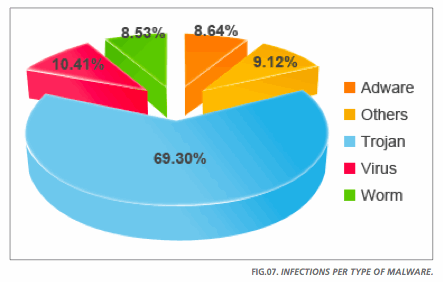The second quarter of 2011 was one of the worst on record in terms of successful hacks and breaches of organizations including RSA, the U.S. Defense Department, the International Monetary Fund, Sony, and Citigroup. With all these high profile breaches, one thing that may have fallen out of the spotlight is the massive volume of malware being created and spread on a daily basis.
In Q2 2011, malware continued to spread substantially, with 42 new malware strains being created every minute (about 60,000 per day), according to PandaLabs.
 According its Quarterly Report for Q2 2011, which analyzed IT security events and incidents from April through June 2011, PandaLabs, the anti-malware lab at Panda Security, says Trojans were responsible for 69 percent of infections, followed by viruses (10 percent) and worms (8.53 percent). Adware, which only represents 1.37 percent of all malware, accounted for more than 9 percent of all the infections, indicating the substantial effort malware writers are taking to promote this type of malicious code. Fake anti-virus programs, which are included in the adware category, have also continued to grow. According to PandaLabs, this shows the interest and the amount of work put in by cybercriminals to ‘promote’ these tools. From a pure cost-benefit perspective this is quite easy to understand, as once cybercriminals spread their fake antivirus software, all they have to do is wait for users to start sending them money.
According its Quarterly Report for Q2 2011, which analyzed IT security events and incidents from April through June 2011, PandaLabs, the anti-malware lab at Panda Security, says Trojans were responsible for 69 percent of infections, followed by viruses (10 percent) and worms (8.53 percent). Adware, which only represents 1.37 percent of all malware, accounted for more than 9 percent of all the infections, indicating the substantial effort malware writers are taking to promote this type of malicious code. Fake anti-virus programs, which are included in the adware category, have also continued to grow. According to PandaLabs, this shows the interest and the amount of work put in by cybercriminals to ‘promote’ these tools. From a pure cost-benefit perspective this is quite easy to understand, as once cybercriminals spread their fake antivirus software, all they have to do is wait for users to start sending them money.
In terms of countries with the highest levels of malware infections, China, Thailand and Taiwan took the top three spots again. In terms of the lowest, PandaLabs says Sweden, Switzerland and Norway were the least infected countries across its user base.
The quarter brought the first large-scale attack on the Mac platform through “rogueware” or fake antivirus software called MacDefender and other variants like MacShield.
In the mobile sector, the number of attacks on Google’s Android platforms has continued to rise.
The full Quarterly Report for Q2 from PandaLabs is available here
















